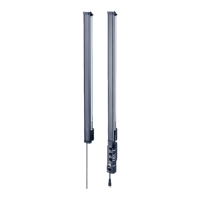What to do if SICK MLG-2 WebChecker show QoR-Alarm?
- RRobin ReedAug 3, 2025
If your SICK Measuring Instruments display a QoR-Alarm, you should clean the sensor, check the alignment, and verify the quality of the material being measured.

What to do if SICK MLG-2 WebChecker show QoR-Alarm?
If your SICK Measuring Instruments display a QoR-Alarm, you should clean the sensor, check the alignment, and verify the quality of the material being measured.
What to do if SICK MLG-2 WebChecker have a sensor teach-in error?
If you encounter a sensor teach-in error with your SICK Measuring Instruments, make sure the front screens are clean and that all light beams are unobstructed during sensor teach-in. Also, check the alignment of the sender and receiver, perform the sensor alignment and teach-in again. Finally, check “Blanking” in the SOPAS settings menu.
What to do if SICK Measuring Instruments have a material teach-in error?
If your SICK Measuring Instruments show a material teach-in error, it might be because no material is located between the sender and receiver, or the material is transparent. You should also check “Blanking” and “Material teach-in” in the SOPAS settings in the menu.
What to do if SICK Measuring Instruments show a sync error?
If your SICK Measuring Instruments are showing a sync error, check the electrical connection and inspect the electrical cables for any breakage.
What to do if SICK MLG-2 WebChecker have a short-circuit?
If your SICK Measuring Instruments have a short-circuit, contact service or replace the device.
What to do if SICK MLG-2 WebChecker have a hardware error?
If your SICK Measuring Instruments are showing a hardware error, contact service.
| Resolution | 0.1 mm |
|---|---|
| Interface | Ethernet, RS-232 |
| Power Supply | 24 V DC |
| Protection Class | IP65 |
| Light source | Infrared LED |
| Response time | 10 ms |
| Operating voltage | 24 V DC |
| Type | WebChecker |
| Measurement Principle | Optical |
| Operating Temperature | -10 °C to +50 °C |
| Number of beams | 2 |
| Protective field height | Up to 2000 mm |
| Ambient operating temperature | -10 °C to +50 °C |
Specifies the qualifications required for personnel mounting and maintaining the MLG-2.
Provides essential safety guidelines for operating the MLG-2.
Details the LEDs and control panel elements on the MLG-2.
Describes the LEDs and control panel for the fieldbus interface.
Explains the LEDs and status indicators on the fieldbus module.
Guides on determining the optimal mounting distance between sender and receiver.
Explains how to find the optimal object position for accurate measurements.
Details how to determine measurement accuracy based on object position.
Specifies the minimum distances required for object detection.
Defines minimum distances for multiple objects in edge measurement.
Explains how to parameterize functions for width and center calculations.
Provides recommendations for mounting MLG-2 units to avoid interference.
Provides a step-by-step guide for correct MLG-2 mounting.
Explains the procedure for mounting the QuickFix bracket.
Details the procedure for mounting the FlexFix bracket.
Explains how to connect cables to the fieldbus module.
Outlines the prerequisites and steps for putting the MLG-2 into operation.
Explains how to align the sender and receiver for optimal signal quality.
Describes the process of sensor teach-in for MLG-2.
Details the procedure for material teach-in.
Details the sensor teach-in process via the control panel.
Details the material teach-in process via the control panel.
Guides through MLG-2 setup using the SOPAS installation assistant.
Details the process for setting up edge measurement in SOPAS.
Overview of PROFINET features and architecture for the MLG-2.
Overview of EtherCAT® features and architecture for the MLG-2.
Overview of Ethernet/IP features and architecture for the MLG-2.
Details how to assign and manage the MLG-2's IP address.
Configures IP address, subnet mask, and DHCP settings.
Guides through sensor alignment using the Installation assistant.
Guides through sensor teach-in within the Installation assistant.
Allows parameterizing and performing material teach-in.
Enables parameterizing functions like width and center measurement.
Allows parameterizing functions for switching outputs and inputs.
Advises on actions to take when a malfunction occurs.
Explains the meaning of LED indicators for fault diagnosis.